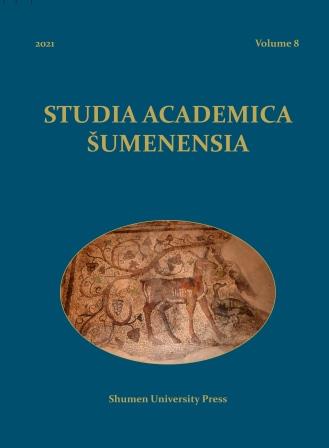An Alan catacomb discovered at Vlădeni-Popina Blagodeasca (Ialomiţa county, Romania)
An Alan catacomb discovered at Vlădeni-Popina Blagodeasca (Ialomiţa county, Romania)
Author(s): Emilia CorbuSubject(s): History, Archaeology
Published by: Шуменски университет »Епископ Константин Преславски«
Keywords: Alan people; catacomb; Huns’ invasion; nomads; the prophilactic rite against the dead
Summary/Abstract: The article contains data about the discovery’s place, tomb’s descriptions, the funeral inventory, the historical and cultural context. The catacomb is like a boot with a burial chamber on its top. It looks like a cone of 2.50 x 2.30 m at the top. Towards the base it widens to 3.50 m. The depth is 2.50 m (fig. 3).1 On the NW side, the pit is strongly vaulted, similarly to a niche. A thick deposit of pottery fragments and bones, some sort of a lid, covers the niches. The human skeleton is laid in supine position, with its head towards the North. The artificially deformed skull is put base up. The legs are bent at the knees to the left and the shanks carefully crossed, the paw of the left foot behind the right shank. The viscerocranium, the right forearm, the spine and ribs are missing. The niches of the pit contained 217 ceramic fragments and 170 fragmentary animal bones of big cattle. The statistical analysis shows that the two categories were almost at parity of 44,23% (96 fragments of fine pottery made on the fast wheel), relative to 46,56% (101 handmade fragments). Only 20 grey-clay paste fragments (9,21%) are found. The pottery’s histogram indicated a date during the second half of 5th century to the first half of the 6th century. The author found analogies in the nomad people’s pottery discovered in Roman-Byzantine fortresses in Dobruja. The Roman – Gothic relationships and the Hun invasion marked the historical context of the 4th-5th century. The Alans from the North Black Sea and Crimea, Lower Moesia and Scythia Minor became federates of the Roman Empire during the reign of Emperor Marcian (450-457). Is it a coincidence that most of the artificially deformed skulls discovered in Romania were discovered in Roman-Byzantine sites during 4th-6th century from Dobruja? The author suggests the catacomb belongs to the Alans. The arguments consist in the cultural analogies, the ritual, the artificially deformed skulls and the mutilated skeletons, a proof of a prophylactic rite against the dead.
Journal: Studia Academica Šumenensia
- Issue Year: 2021
- Issue No: 8
- Page Range: 35-56
- Page Count: 22
- Language: English

